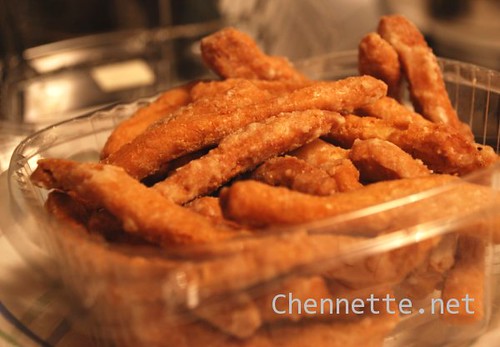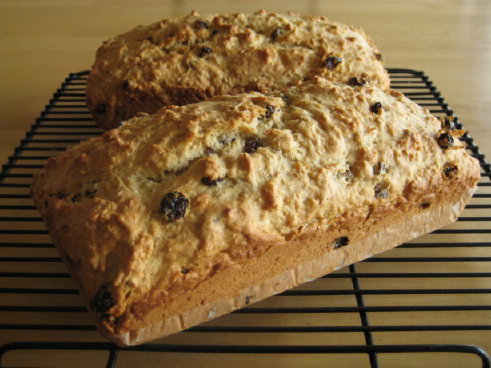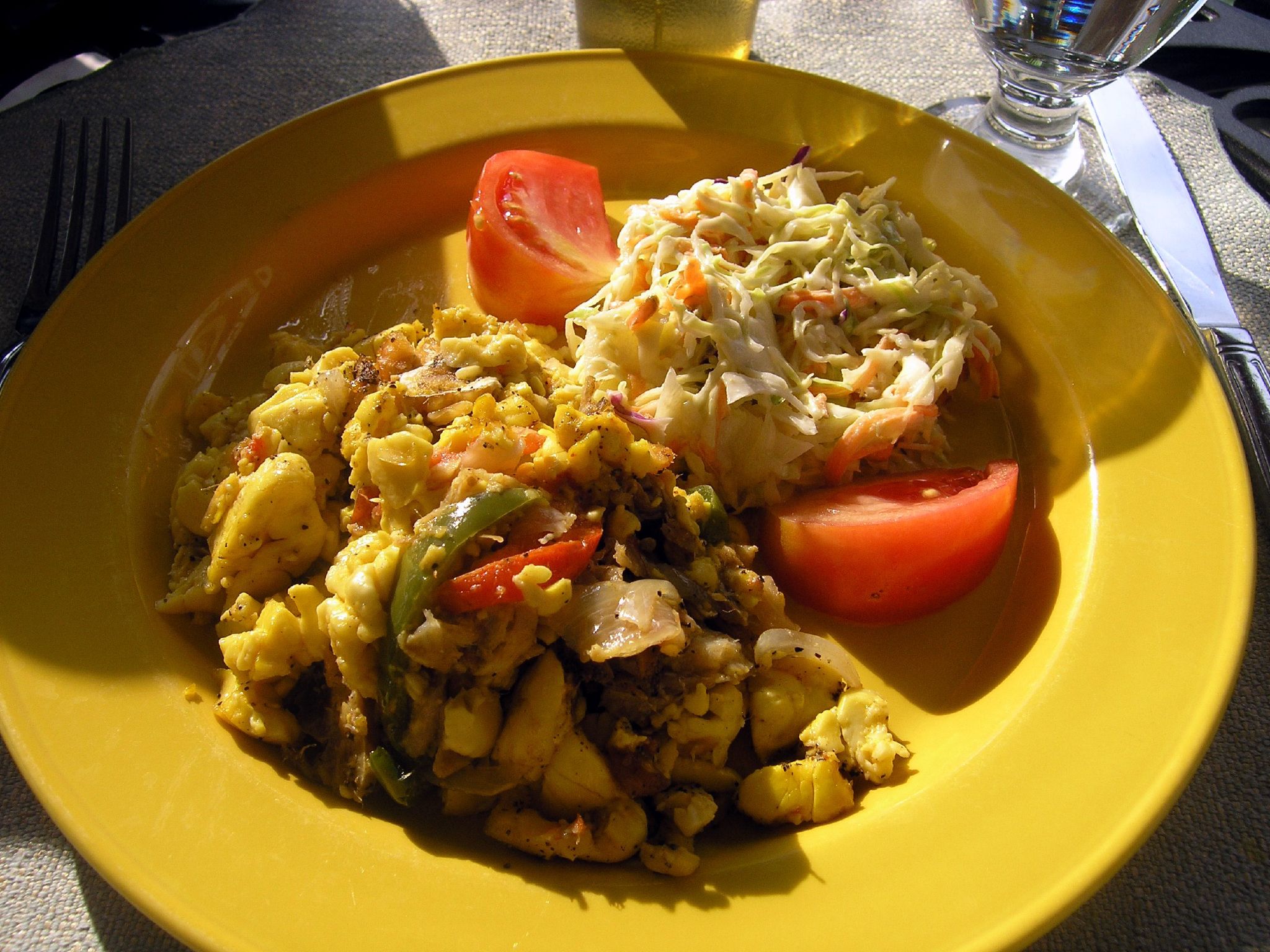Thursday, June 28, 2012
Oxtail
Oxtail (occasionally spelled ox tail or ox-tail) is the culinary name for the tail of cattle. Stewed oxtail with butter beans or as main dish (with rice) is popular in Jamaica, Trinidad, and other West Indian cultures.
Recipe:
http://caribbeanpot.com/the-ultimate-oxtail-stew/
Sources:
http://en.wikipedia.org/wiki/Oxtail
http://www.simplyrecipes.com/photos/oxtail-stew-b.jpg
http://img.foodnetwork.com/FOOD/2008/01/18/PA1203_Country_Oxtails_lg.jpg
(I do not own the rights of these images)
Mango Chow
Mango Chow. Trinidadians love mango chow and I am no different. This simple appetizer is great during hot evenings, with good company. It is seasoned green or half ripe mango with a little pepper (no cooking is required).
*You can also use other fruits, the second picture is pineapple used as a substitute.
Recipe:
http://www.foodnetwork.ca/recipe/mango-chow/10937/
Sources:
http://www.simplytrinicooking.com/2008/08/mango-chow.html#axzz1z7OJ829T
http://s1.hubimg.com/u/2251868_f520.jpg
http://caribbeanpot.com/wp-content/uploads/2010/01/trini-pineapple-chow-recipe-300x199.jpg
(I do not own the rights to these images)
Labels:
caribbean,
fruit,
mango chow,
mangos,
trini,
trinidad,
west indies
Sorrel
Sorrel is synonymous with Christmas in Trinidad and Tobago. In every home you can find this drink being made in preparation for invited guests or parranderos during the Christmas season. The drink is made from the bright, red sepals of the sorrel plant (Hibiscus Sabdariffa) that is sour in taste.
Recipe:
Sources:
http://www.simplytrinicooking.com/2008/12/sorrel-drink.html#axzz1z7OJ829T
http://searchdominica.com/wp-content/uploads/2010/11/sorrel_drink.jpg
http://grenadabluehorizons.files.wordpress.com/2010/12/sorrel-flower.jpg
(I do not own the right to these images)
Labels:
caribbean,
christmas season,
flower,
parang,
sorrel,
west indian
Kurma
Kurma is an Indian delicacy that is made and sold commercially in Trinidad and Tobago. It is also served at many Indian family functions.
Recipe:
http://www.simplytrinicooking.com/2008/09/kurma.html#axzz3BAH3jDrv
Sources:
www.whatocook.com/kurma.html
http://farm3.staticflickr.com/2269/1752455407_f649659a9f.jpg
http://farm4.static.flickr.com/3588/3425976453_b7ece4ebb5.jpg
(I do not own the rights to these images)
Labels:
east indian,
guyana,
indian food,
Kurma,
trinidad,
trinidad and tobago,
west indian
Toolum
Toolum. In the early part of the twentieth century, sweet vendors would pound the streets of towns and villages in T&T, selling candies by means of a spinning wheel. For a penny, a customer spun the wheel and received the number candies indicated when the wheel stopped--up to fifty. Toolum, one of the earliest T&T candies, was undoubtedly supplied by such vendors.
Recipe:
http://www.simplytrinicooking.com/2012/02/toolum.html#axzz3BAH3jDrv
Sources:
http://recipes.caribseek.com/Trinidad_and_Tobago/toolum.shtml
http://food.sndimg.com/img/recipes/19/24/64/large/picO5a3Pt.jpg
(I do not own the rights to these images)
Coconut Bread or Sweet Bread
Coconut bread, better known in the caribbean as ‘sweet bread’, is extremely popular as it has a great, unique taste.
Recipe:
http://caribbeanpot.com/how-to-make-coconut-sweet-bread/
Sources:
http://cakecentral.com/recipe/caribbean-coconut-loaf
http://asymptotia.com/wp-images/2008/01/mums_coconut_bread.jpg
(I do not own the rights to these images)
Labels:
barbados,
caribbean,
coconut break,
grenada,
jamaican,
sweet break,
trinidad,
west indies
Wednesday, June 27, 2012
Pelau or Cook up
Pelau or Cook up is a stew from Trinidad made with either beef or chicken. The unique flavor comes from searing the meat in caramelized sugar then simmering with rice, coconut milk, and pigeon peas. Serve accompanied by slices of tomato, avocadoes, or cucumber.
Recipe:
http://www.cookingwithria.com/2011/07/trinidad-pelau.html
Sources:
http://allrecipes.com/recipe/trinidad-pelau/
http://www.trinigourmet.com/wp-content/uploads/bertiestrinidadpelau/trinidadpelau.jpg
http://caribbeanfoodrecipes.net/wp-content/uploads/2011/11/pelau.jpg
(I do not own the rights to these images)
Callaloo
Callaloo (sometimes calaloo or kallaloo) is a popular Caribbean dish originated from West Africa served in different variants in across the Caribbean. The main ingredient is a leaf vegetable, traditionally either amaranth (known by many local names including callaloo or bhaaji), taro or Xanthosoma. Both are known by many names including callaloo, coco, tannia, bhaaji, or dasheen bush. Because the leaf vegetable used in some regions may be locally called "callaloo" or "callaloo bush", some confusion can arise among the different vegetables and with the dish itself. Outside of the Caribbean, water spinach is occasionally used. Trinidadians primarily use taro/dasheen bush for callaloo, while Jamaicans and Guyanese use the name callaloo to refer to amaranth, and use it in a plethora of dishes and also a drink ('callaloo juice'). It should be understood that the 'callaloo' made in Jamaica is different from the 'callaloo' made in Trinidad and Tobago in terms of main ingredient (the leaf used) and other ingredients included (for example, Jamaicans tend to use only callaloo leaf, salt, onions, escallion and simply steam the vegetable, while Trinidadians use okra and coconut milk to make an entirely different dish with a different taste and consistency).
Recipe:
http://latinfood.about.com/od/maindishes/r/Callaloo-Recipe.htm
Sources:
https://blogger.googleusercontent.com/img/b/R29vZ2xl/AVvXsEgYlhHf3j42MhJuvk-diHLY5ez-HFrf-E1H21xYVlx-uJcWQdeIqzCHS5eRTy3FPJjsFuraULDo0KIi3-2FiXVodPKyaZGNrlB7jfcI4VoAjfDi_kZqME6emkzk5hKdbXxU1Q4WIzBBElY/s320/IM000846.jpg
(I do not own the rights to these images)
Jamaican Festival
Jamaican Festival slightly sweet cornmeal fried ‘dumplings’, they are traditionally served alongside spicy meat dishes, such as Jamaica’s infamous ‘jerk’. The sweetness offsets the meat, pepper and spices most sublimely, and the doughy texture is ideal for soaking up gravy and sauces.
Recipe:
http://leitesculinaria.com/78182/recipes-festival-jamaican-fried-dough.html
Sources:
http://www.trinigourmet.com/index.php/jamaican-festival-recipe/
https://blogger.googleusercontent.com/img/b/R29vZ2xl/AVvXsEjDvWKfgBY9sYoh3h6AQ-Yil9gLmoxItRehurURyaQobAvCIk1SjGFcDwJKyGdoPQyOUw8EFJGKHa8qdBWwhtqdZ3Jc54x_RZeyeVcI2ywvGMylpS7QloqvZZHb0zVgcCvwU3lJYvN2pyrO/s400/DSC03049-12.jpg
(I do not own the rights of these images)
Labels:
caribbean,
dumplin,
jamaican,
Jamaican fesitival,
west indies
Saheena
Saheena is a wonderful East Indian delicacy that is suitable for all occasions. The filling consists of lots of chopped spinach and stirred in a split pea flour base and then fried. Lots of spices and peppers go into the filling as well including cumin, minced garlic, curry powder, and onions. The product is filling and delicious.
Recipe:
http://www.trinigourmet.com/index.php/trinidad-saheena-recipe/
Sources:
http://www.travelingted.tv/2012/04/05/seven-delicious-street-foods-in-trinidad-tobago/
http://www.trinigourmet.com/wp-content/uploads/saheena/trinidadsaheena.jpg
http://caribbeanpot.com/wp-content/uploads/2010/11/saheena-recipe-trinidad.jpg
(I do not own the rights of these images)
Labels:
caribbean,
east indian,
saheena,
trini,
trinidad,
west indies
Tuesday, June 26, 2012
Bake and Shark
Bake and Shark is a very popular street food sold in Trinidad and Tobago. It is one of those must-try items for visitors to the twin-island Republic and for locals, a week without eating Bake and Shark would just seem unnatural.
Bake refers to fried dough. It is a dough made of all purpose flour, baking powder, a pinch of salt, a little grease (preferably butter) and brought together with water. Once rested, the dough is then divided into 3-inch balls, rolled into flat discs and fried until it puffs up. The inside of the bake is hallow and therefore, it is the perfect vehicle for stuffing or sandwiching things.
Shark is shark. Well, not the huge ones we see in movies and on television, these are much smaller shark. They are skinned, deboned, and sold filleted. The shark is seasoned with green seasoning, along with salt and pepper, breaded and pan fried.
Recipe:
http://www.simplytrinicooking.com/2009/02/bake-and-shark.html#axzz3BAH3jDrv
Sources:
http://latinfood.about.com/od/maindishes/a/bake-and-shark.htm
https://blogger.googleusercontent.com/img/b/R29vZ2xl/AVvXsEirh3A28Nv4J6VgNMPFTtJxqhmepRiZ1qXKvz8lkrqeaPIyCS05e7xWWyVrXW4oB-J4U_6BvZoyw9QRz971V4wvQSL_8hBN6yckZY0awsdTfnW0zrVpWXJNzlONH8vnagAtBeji-PVdB_o/s1600/bs3.jpg
http://photos.igougo.com/images/p363252-Trinidad_and_Tobago-Shark_Sandwich.jpg
(I do not own the rights to these images)
Labels:
Bake and Shark,
caribbean,
maracas beach,
trinidad,
west indian
Pholourie
Pholourie are basically little balls of split pea flour fried and served in a thin sweet chutney sauce (usually mango or tamarind). You can buy them in little paper bags with the sauce in a little plastic bag included.
Recipe:
http://www.simplytrinicooking.com/2008/09/pholourie.html#axzz3BAH3jDrv
Sources:
http://www.trinigourmet.com/index.php/pholourie-recipe/
https://blogger.googleusercontent.com/img/b/R29vZ2xl/AVvXsEjmqKNmLBu9ZVS1EtfA1ICAaw1PSND2Jk2FhhGgpSNtR7bKc_hqQlDSvp0HPF92DBzApgVrc1J7DaJ4NoZGFK8Eq_9mFHOYBHnvNSm_KtcedQKsyUHEpN5V2GmEQ3y46GUv8Go99s87IYOn/s1600/Pholourie+057.JPG
http://www.preschag.com/forums/uploads/1204414017/med_gallery_42_10_1074160.jpg
(I do not own the rights to these images)
Labels:
indian food,
pholourie,
split peas,
trinidad,
west indian,
west indies
Monday, June 25, 2012
Ackee and Salt Fish
Ackee and saltfish is a traditional Jamaican dish, internationally known as Jamaica's national dish. It spread to other countries with the Jamaican diaspora.
The ackee fruit was imported to Jamaica from West Africa (probably on a slave ship) before 1778. It is also known as blighia sapida. The scientific name honours Captain William Bligh who took the fruit from Jamaica to the Royal Botanic Gardens in Kew, England in 1793 and introduced it to science. Because parts of the fruit are toxic, there are shipping restrictions when being imported.
To prepare the dish, salt cod (packet salt fish may need to be boiled down and should be free of 'pink' mould) is sautéed with boiled ackee, onions, Scotch Bonnet peppers (optional), tomatoes, and spices, such as black pepper and pimiento. It can be garnished with crisp bacon and fresh tomatoes, and is usually served as breakfast or dinner alongside breadfruit, hard dough bread, dumplings, fried plantain, or boiled green bananas.
Recipe:
http://cooklikeajamaican.com/ackee-and-saltfish/
Sources:
http://en.wikipedia.org/wiki/Ackee_and_saltfish
http://upload.wikimedia.org/wikipedia/commons/7/75/Ackee_and_Saltfish.jpg
http://caribbeanpot.com/wp-content/uploads/2011/04/jamaican-ackee-and-saltfish-300x199.jpg
(I do not own the rights of these images)
Labels:
ackee and saltfish,
Buljol,
caribbean,
jamaican,
london,
west indian,
west indies
Aloo Pie
An aloo pie is a variant of the samosa popular in Trinidad and Tobago.[1] It is a soft, fried pastry made from flour and water, and filled with boiled, spiced and mashed potatoes (aloo being a romanization of the Hindi word for "potato") and other vegetables like green peas or chana dal (split chickpeas without their seedcoat).
Recipe:
http://caribbeanpot.com/trinbago-aloo-pie-recipe/
Sources:
http://en.wikipedia.org/wiki/Aloo_pie
http://upload.wikimedia.org/wikipedia/commons/4/49/Aloo_Pie.jpg
http://caribbeanpot.com/wp-content/uploads/2010/09/aloo-pie.jpg
(I do not own the rights to these images)
Labels:
aloo pie,
caribbean,
indian food,
potato,
trini,
west indian
Jamaican Patty
A Jamaican patty is a pastry that contains various fillings and spices baked inside a flaky shell, often tinted golden yellow with an egg yolk mixture or turmeric. It is made like a turnover but is more savoury. As its name suggests, it is commonly found in Jamaica, and is also eaten in other areas of the Caribbean, such as Costa Rica's Caribbean coast. In Haiti, the pastry is thick and crisp, making it essentially a turnover. It is traditionally filled with seasoned ground beef, but fillings can include chicken, vegetables, shrimp, lobster, fish, soy, ackee, mixed vegetables or cheese.
Recipe:
http://eatjamaican.com/recipes/beefpatty-recipe.html
Sources:
http://en.wikipedia.org/wiki/Beef_Patties
http://upload.wikimedia.org/wikipedia/commons/e/ef/Jamaican_patties_and_redstripe.jpg
http://www.nextuplocal.com/CMSFiles/548/jamaican_patties.jpg
(I do not own the right to these images)
Labels:
caribbean,
golden yellow,
jamaican patty,
pastry,
west indian
Doubles
Doubles is a common street food in Trinidad and Tobago. It is a sandwich made with two bara (flat fried bread) filled with channa (curried chick peas or garbanzo beans). Topped with a variety of spicy chutneys (mango, cucumber, coconut, tamarind) and extra pepper sauce (ranging from a dash "slight" to much more), this delicacy is the most popular fast food in Trinidad and Tobago. It is usually eaten for breakfast, and sometimes lunch, but can be a late night snack as well.
Recipe:
http://www.trinigourmet.com/index.php/trinidad-doubles-recipe/
Sources:
http://en.wikipedia.org/wiki/Doubles_(food)
http://whatsonmyplate.net/wp-content/uploads/2009/06/doubles.jpg
http://www.theoneonefour.com/wp-content/uploads/2009/09/double.jpg
(I do not own the rights to these images)
Labels:
bara,
channa,
curry,
doubles,
guyana,
indian food,
suriname,
trini,
trinidad,
west indian
ROTI
In the West Indies the word roti refers not only to the pastry but to the complete pastry with some sort of savory filling. In Asia 'roti' means what West Indians would call 'roti skins.' Roti also features prominently in the diet of many West Indian countries, especially Trinidad and Tobago, Guyana and Suriname. West Indian roti are primarily made from wheat flour, baking powder, salt, and water and cooked on a tava.
Recipe:
http://www.simplytrinicooking.com/2008/10/dhal-puri-roti.html#.U_fTWvldU8c
Sources:
http://en.wikipedia.org/wiki/Roti
http://farm4.static.flickr.com/3284/2971387057_a9ce01873a.jpg
http://caribbeanpot.com/wp-content/uploads/2010/12/roti.jpg
(I do not own the rights to any of the images)
Labels:
curry,
guyana,
indian food,
roti,
suriname,
trini,
trinidad,
west indian
Subscribe to:
Posts (Atom)



























